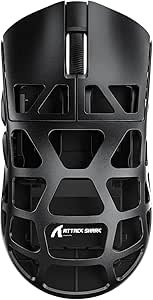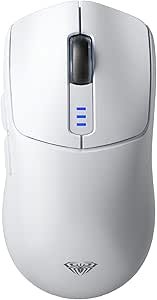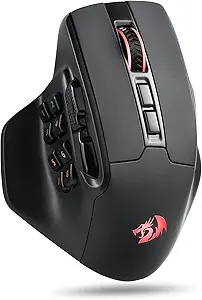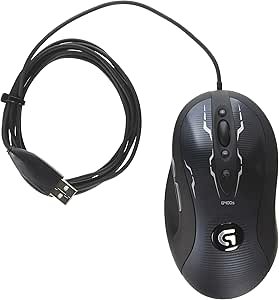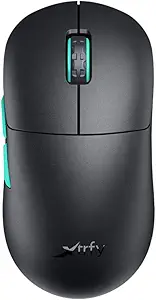Review of the ultra-light ATTACK SHARK R3 wireless gaming mouse for esports enthusiasts
Review of the ultra-light ATTACK SHARK R3 wireless gaming mouse for esports enthusiasts
- Ultra-lightweight design ensures maximum comfort and agility during extended gameplay sessions.
- Exceptional precision with the PixArt PAW3395 sensor delivers unparalleled accuracy for competitive gaming.
- Durable Kailh GM 8.0 switches provide crisp, tactile clicks, enhancing responsiveness and longevity.
- Tri-mode connectivity options allow seamless switching between Bluetooth, 2.4GHz wireless, and wired modes.
- Extended battery life up to 200 hours ensures uninterrupted gaming without frequent recharges.
As an Amazon Associate I earn from qualifying purchases.
Description
A Gaming Mouse That Redefines Lightweight and Precision
The ATTACK SHARK R3 46g Superlight Magnesium Alloy Wireless Gaming Mouse brings an ambitious promise to the table with its ultra-lightweight design, top-tier wireless technology, and sensor capabilities. After putting it through its paces, I can confidently say the product delivers in many areas, though there are a few quirks to keep in mind.
Design and Build Quality: A Featherweight Marvel
I’ve used a lot of gaming mice, but this one genuinely caught me off guard with its 46g weight. The magnesium alloy construction paired with a hollowed design makes it almost unbelievably light without feeling flimsy. Unlike some lighter mice that sacrifice durability, this one achieves a balance, thanks to its CNC one-piece molding process. It feels solid in hand, which is impressive considering its weight.
The ergonomics are spot on, fitting comfortably in my palm during long gaming sessions. Its matte finish resists fingerprints, which is always a bonus in my book. However, the hollowed design may not appeal to everyone aesthetically, as it leans heavily into the futuristic gamer vibe.
Performance: Speed and Precision Combined
One of the standout features of this mouse is the PixArt PAW3395 sensor, which supports up to 26,000 DPI. Personally, I set the DPI somewhere in the 3,000–5,000 range for FPS games, and the tracking was flawless. The 650 IPS speed and 50g acceleration ensure that even the quickest flicks register accurately, making it a joy to use in fast-paced titles.
The 8000Hz polling rate is a game-changer if you’re looking for ultra-responsive performance. Coming from a 1000Hz mouse, the difference in responsiveness is noticeable, especially in competitive shooters. The clicks from the Kailh GM 8.0 switches feel tactile and satisfying, with no mushiness. The TTC scroll wheel encoder adds precision when scrolling through weapons or zooming in sniping modes.
Tri-Mode Connectivity: Versatility at Its Best
Connectivity is where this mouse truly shines. You can switch between Bluetooth, 2.4GHz wireless, and wired mode using a simple button on the back. I primarily used the 2.4GHz wireless mode, and the connection was rock-solid with no noticeable lag. The 200-hour battery life is another huge plus, as I didn’t find myself reaching for the charging cable often.
That said, Bluetooth mode feels more suited for casual use rather than gaming. The latency is slightly higher, and while it’s functional, it doesn’t hold up to the HYPERSPEED Wireless performance.
Cloud Driver: A New Spin on Customization
Customization is handled via a cloud driver, which eliminates the need for traditional software downloads. While I initially found this concept intriguing, it’s a bit of a mixed bag in practice. The DPI adjustment, macro recording, and key mapping options are all there, but accessing them through a webpage feels clunkier compared to a dedicated app. On the flip side, it’s incredibly lightweight on system resources, so I can see why some users might prefer it.
Key Benefits
- Ultra-lightweight design enhances speed and reduces wrist fatigue.
- 8000Hz polling rate ensures incredibly fast response times.
- PixArt PAW3395 sensor delivers top-notch accuracy for competitive gaming.
- Tri-mode connectivity offers unparalleled versatility.
- 200-hour battery life reduces the need for frequent charging.
Shortcomings
- The cloud driver system isn’t as intuitive as dedicated software.
- Bluetooth mode latency makes it less ideal for gaming.
- Hollowed design may not appeal to users seeking a more traditional look.
Competing Products
Compared to other light gaming mice, such as the Razer Viper V2 Pro or the Logitech G Pro X Superlight, the R3 manages to hold its ground impressively. While the Viper V2 Pro has a more polished software suite and the G Pro X offers a slightly more traditional build, neither can match the 8000Hz polling rate of the R3. Additionally, the magnesium alloy construction feels more premium than the plastic shells of its competitors.
On the flip side, the cloud driver system of the R3 lags behind the intuitive software from Logitech and Razer. If you prioritize ease of customization, you might lean toward those brands. However, for sheer performance and weight, the R3 edges ahead.
True Value
In terms of price to performance, this mouse is a steal for gamers who prioritize speed, precision, and cutting-edge features. Its 8000Hz wireless polling rate and PixArt sensor alone make it a standout choice for competitive players. While the cloud driver system may require some patience, the overall package is hard to beat at this price point. It’s a rare combination of innovation and affordability that delivers real value for money.
Additional information
| Package Dimensions | 6.77 x 4.17 x 2.83 inches |
|---|---|
| Item Weight | 1.62 ounces |
| Item model number | R3 |
| Manufacturer | ATTACK SHARK |
| Country of Origin | China |
